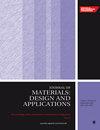纳米陶瓷颗粒增强高合金化铝-锌-镁-铜复合材料
IF 2.2
4区 材料科学
Q3 MATERIALS SCIENCE, MULTIDISCIPLINARY
Proceedings of the Institution of Mechanical Engineers, Part L: Journal of Materials: Design and Applications
Pub Date : 2024-08-02
DOI:10.1177/14644207241269595
引用次数: 0
摘要
在用纳米颗粒增强的金属基复合材料(MMC)中,复合材料性能的提高往往与纳米颗粒的种类密切相关。探索各种纳米粒子对高合金铝基复合材料微观结构演变和力学性能的影响和差异至关重要。本研究首次采用热压工艺制备了分别以 SiC 和 Al2O3 纳米陶瓷颗粒增强的 Al-Zn-Mg-Cu 复合材料。通过热挤压和 T6 热处理技术,系统研究了纳米陶瓷颗粒的添加对铝锌镁铜复合材料微观结构演变和力学性能的影响,并对两种复合材料进行了对比分析。实验结果表明,SiC/Al2O3 纳米陶瓷颗粒的加入消耗了 α-Al 基体中的镁原子,从而细化了晶粒尺寸初级 η'(MgZn2)强化相,提高了 Al-Zn-Mg-Cu 复合材料的整体力学性能。其中,SiC 纳米陶瓷颗粒的加入通过界面反应生成了 Mg2Si 相,在沉淀强化和奥罗旺强化的协同作用下,Al-Zn-Mg-Cu 复合材料的极限抗压强度和压缩性分别提高到了 844 兆帕和 27.5%。另一方面,Al2O3 纳米陶瓷颗粒的加入可在晶界形成富氧相和细化析出物。因此,复合材料的伸长率提高到 43.5%,同时还能保持较高的极限抗压强度。预计纳米陶瓷颗粒增强铝基金属复合材料在实现高强度和优异延展性方面具有巨大潜力,可应用于工业领域。本文章由计算机程序翻译,如有差异,请以英文原文为准。
Nanoceramic particle reinforced high alloying Al-Zn-Mg-Cu composites
In the metal matrix composites (MMCs) reinforced with nanoparticles, the enhancement of composite performance is often closely associated with the types of nanoparticles. It is vital to explore the influences and differences of various nanoparticles on the microstructure evolution and mechanical properties of highly alloyed aluminum-based composites. This study is the first to employ hot pressing for preparing Al-Zn-Mg-Cu composite materials reinforced with SiC and Al2 O3 nano-ceramic particles, respectively. By employing hot extrusion and T6 heat treatment techniques, a systematic investigation was conducted on the effects of the addition of nano-ceramic particles on the microstructure evolution and mechanical properties of the Al-Zn-Mg-Cu composites, and a comparative analysis was performed on the two types of composite materials. The experimental results demonstrated that the Mg atoms in the α-Al matrix were consumed by the addition of SiC/Al2 O3 nano-ceramic particles, and thereby the grain size primary η’ (MgZn2 ) strengthening phase was refined, leading to an enhanced overall mechanical performance of the Al-Zn-Mg-Cu composite. In particular, the Mg2 Si phase was generated by the addition of SiC nanoceramic particles, through the interfacial reactions, and thus with the synergistic effects of precipitation strengthening and Orowan strengthening, the ultimate compressive strength and compressibility of Al-Zn-Mg-Cu composite can be increased to 844 MPa and 27.5%, respectively. On the other hand, the addition of Al2 O3 nanoceramic particles can bring about the formation of an oxygen-rich phase and refined precipitates at grain boundaries. Accordingly, the elongation is increased to 43.5% while a high ultimate compressive strength in the composites can be maintained. It is anticipated that nanoceramic particle-reinforced Al-based metal composites have significant potential for achieving both high strength and exceptional ductility for the application in the industry field.
求助全文
通过发布文献求助,成功后即可免费获取论文全文。
去求助
来源期刊

CiteScore
4.70
自引率
8.30%
发文量
166
审稿时长
3 months
期刊介绍:
The Journal of Materials: Design and Applications covers the usage and design of materials for application in an engineering context. The materials covered include metals, ceramics, and composites, as well as engineering polymers.
"The Journal of Materials Design and Applications is dedicated to publishing papers of the highest quality, in a timely fashion, covering a variety of important areas in materials technology. The Journal''s publishers have a wealth of publishing expertise and ensure that authors are given exemplary service. Every attention is given to publishing the papers as quickly as possible. The Journal has an excellent international reputation, with a corresponding international Editorial Board from a large number of different materials areas and disciplines advising the Editor." Professor Bill Banks - University of Strathclyde, UK
This journal is a member of the Committee on Publication Ethics (COPE).
 求助内容:
求助内容: 应助结果提醒方式:
应助结果提醒方式:


